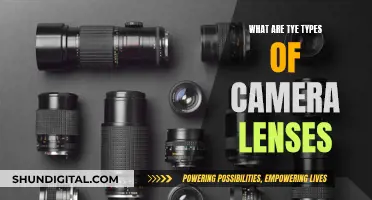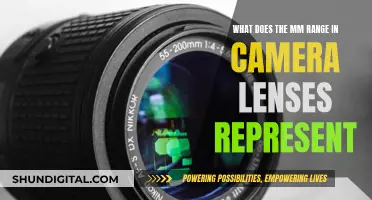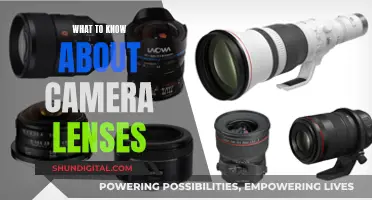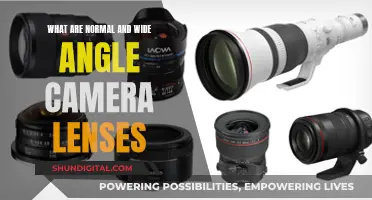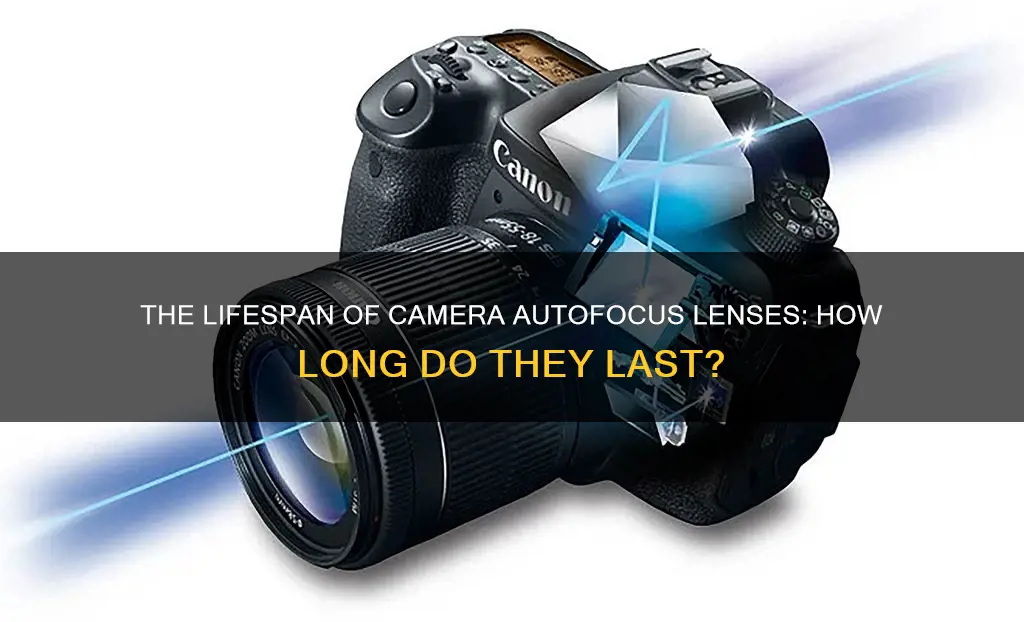
Camera lenses are made to last for years, but their longevity depends on several factors. The initial build quality, the way they are stored, and the conditions they are used in all play a role in determining how long a camera lens will last.
Lenses from well-known brands like Canon, Nikon, and Sony are generally built to last, but cheaper third-party manufacturers may not put in the same amount of care and testing. Additionally, some companies produce cheaper lenses that use more affordable parts to keep the price low, so these may not last as long as more expensive models.
Proper storage is crucial to protecting lenses. Humidity is a common enemy, as it can lead to moisture and fungus developing inside the lens, damaging internal components. Extreme temperatures can also be harmful. Therefore, it is recommended to store lenses in a dry place with an even temperature.
Physical damage should also be avoided, as drops and collisions can shorten the lifespan of a lens. Using a lens in extreme heat or cold may also put more wear on it. Weather-sealed lenses are ideal for protecting against rain, dust, and excessive humidity.
With proper care, a camera lens should last longer than the camera body itself, which typically has a lifespan of around 150,000 to 300,000 pictures. Some sources suggest that lenses can last for decades, especially if they are high-quality and well-maintained. However, electronic parts in modern autofocus lenses may degrade or fail over time, and mechanical parts can also experience problems.
| Characteristics | Values |
|---|---|
| Lifespan | Longer than the camera body, potentially decades |
| Factors determining lifespan | Storage, damage, build quality, usage conditions, surrounding conditions, weather sealing |
| Signs of wear and tear | Damage to casing or glass, scratches on glass, dark spots in photos, autofocus malfunction |
| Repair | Possible but may be costly due to parts availability |
What You'll Learn
- Autofocus lenses can last for over a decade if stored and used correctly
- Autofocus lenses are more likely to fail if used in extreme conditions
- Autofocus lenses are more prone to damage from humidity
- Autofocus lenses can be repaired if they fail
- Autofocus lenses are more likely to fail if they are cheaper or made by third-party manufacturers

Autofocus lenses can last for over a decade if stored and used correctly
The life of a camera lens depends on several factors, including storage, usage, and the initial build quality. Properly storing your lenses is crucial to protecting them. Humidity is a common enemy of camera lenses, as it can lead to moisture buildup and, eventually, fungus, which can damage internal components. Therefore, it is essential to store your camera and lenses in a dry place, preferably at a consistent temperature. Additionally, extreme heat can also be damaging, so it is best to avoid storing your equipment in hot environments.
Another factor that affects lens longevity is how you use it. Physical damage, such as drops or collisions, can shorten the lifespan of your lens. Shooting in extreme heat or cold can also put more wear on the lens compared to shooting in moderate temperatures. If your lens is not weather-sealed, it is best to avoid conditions like rain, dust, and excessive humidity, as they can affect the internal components.
The initial build quality of the lens also plays a role in its longevity. While well-known brands like Canon, Nikon, and Sony are known for their high-quality lenses, third-party manufacturers may have more variability in their build quality. Additionally, some companies offer lenses at different price points, with cheaper options often using more affordable parts, which may not last as long as more expensive, durable models.
With proper care and maintenance, autofocus lenses can last for over a decade. However, it is important to keep them in suitable storage conditions and avoid physical damage or extreme environmental conditions to ensure their longevity.
Double Lens Cameras: More Accurate or Just a Gimmick?
You may want to see also

Autofocus lenses are more likely to fail if used in extreme conditions
Autofocus lenses can fail in extreme conditions, and there are several reasons why this might happen. Firstly, extreme temperatures can affect the performance of autofocus lenses. Very cold temperatures can cause autofocus failure, and extreme heat can also put more wear on the lens. In addition, autofocus lenses require a minimum amount of light to function, so low-light conditions or environments with little contrast can also cause autofocus failure. For example, during a snowstorm, the visibility and contrast are reduced, making it difficult for the autofocus to work effectively. Similarly, autofocus lenses may struggle in environments with repetitive patterns or specular reflections, as these can confuse the autofocus system. Therefore, it is important to be mindful of the lighting and environmental conditions when using autofocus lenses to avoid potential failure.
Another factor that can contribute to autofocus failure in extreme conditions is physical damage. Drops, collisions, and shock damage can all impact the performance of autofocus lenses. This is particularly relevant in extreme conditions, as these situations may increase the risk of physical damage to the equipment. For example, taking photos in a rainy environment or near the sea can expose your camera to water damage, which can harm the components in your lens and affect autofocus performance. Additionally, complex mechanical parts in autofocus lenses can be sensitive to extreme conditions and may be more prone to failure or degradation over time. The electronics in modern autofocus lenses can also degrade or fail due to age, even if the lens casing and glass are well-maintained.
To minimise the risk of autofocus failure in extreme conditions, it is essential to properly maintain and store your lenses. Storing lenses in a dry place with stable temperatures can help prevent moisture and fungus development, which can damage internal components. Taking precautions, such as using moisture-absorbing packets or investing in a dehumidifier or electronic dry cabinet, can also help protect your lenses in humid environments. Additionally, ensuring your lenses are weather-sealed or taking measures to avoid conditions like rain, dust, and excessive humidity can further reduce the chances of autofocus failure.
The Future of Photography: Cameras in Contact Lenses
You may want to see also

Autofocus lenses are more prone to damage from humidity
If you don't live in an incredibly humid area, you probably don't need special equipment to prevent this. Just make sure to store your camera in a dry place, preferably at an even temperature. Keeping your camera in an area that's too hot is also damaging.
When humidity is more of a problem for your area, you can use tricks like storing your camera in a bag with moisture-absorbing packets. These will dry out the air in the bag, keeping moisture and fungus from forming in your camera.
If you want to go a step further and have peace of mind even in very humid conditions, you can invest in a dehumidifier or an electronic dry cabinet. The latter is a sealed container that, when plugged in, maintains dry conditions on the inside.
- Avoid air conditioning: One of the most common ways photographers fall victim to lens fogging is to go from an air-conditioned space to a hot, humid environment. In this situation, the camera is much cooler than the dew point outside, so condensation rapidly accumulates on the lens and camera.
- Persistent fogging: There are times when there is no temperature change, but your camera may seem to spontaneously fog up. In my experience, this occurs when lots of water has accumulated either in my camera bag or, worse, in my equipment. In these cases, it seems to be the evaporation of the existing moisture in your equipment that causes it to fog.
- Lens fungus and mould: As bad as lens fog can be, the bigger long-term concern is lens fungus and mould. Once fungus starts growing in your lens, there is no good way to undo the damage. It is usually very difficult and expensive to repair.
- Camera and lens fogging: Imagine that you're in the rainforest. You see a jaguar that's just captured its next meal, and you raise your camera to document this incredible moment. But the camera's autofocus searches, and all you see through your viewfinder is a low-contrast blur. You realise your lens has fogged up. Even though you desperately wipe away the fog, it returns within seconds—it's inside your lens, too.
- Tips to keep your camera dry: When I'm shooting in the rainforest, I keep my camera and each lens in its own Ziploc bag with a couple of silica gel desiccant packets. This keeps my gear dry when I'm not using it and helps dry it out again after each usage.
Infinity Focus: Are Camera Lenses Capable?
You may want to see also

Autofocus lenses can be repaired if they fail
Autofocus (AF) lenses use a combination of sensors, control systems, and motors to automatically focus on a selected point or area. There are two main types of AF systems: active and passive. Active AF systems use a beam of light to measure the distance between the camera and the object, while passive AF systems analyse the image entering the optical system to determine correct focus. Hybrid AF systems combine both active and passive methods to improve reliability and accuracy.
Over time, AF lenses may experience issues with their electronic components, such as the autofocus motor or sensors. In some cases, these issues can be repaired or replaced. However, the availability of replacement parts may depend on the age and model of the lens. Older lenses or those that have been discontinued may have limited replacement parts available, making repairs more challenging.
Additionally, physical damage to the lens casing or glass can also affect the performance of AF lenses. Careful use and proper storage are essential to prevent such damage.
It is recommended to consult a professional repair service to diagnose and repair AF lens issues. They will have the necessary tools and expertise to disassemble the lens, access the internal components, and make the necessary repairs. While it is possible to attempt a DIY repair, it is a delicate process and may void the lens's warranty if not done properly.
Overall, while AF lenses can be repaired, the feasibility and cost of repairs will depend on the specific lens and the nature of the issue. Proper care and maintenance are crucial to prolonging the lifespan of AF lenses and minimising the need for repairs.
Handcrafted Zeiss Lenses: Precision and Artistry in Optics
You may want to see also

Autofocus lenses are more likely to fail if they are cheaper or made by third-party manufacturers
The longevity of autofocus lenses depends on several factors, including storage conditions, usage, and the initial build quality. While it is challenging to provide an exact timeframe for their lifespan, proper care and maintenance can significantly extend their durability.
Third-party manufacturers have gained prominence in the market by offering innovative features and competitive prices. However, the question of their longevity compared to first-party lenses remains a subject of debate. Here are some insights into why autofocus lenses from cheaper or third-party manufacturers may be more prone to failure:
Build Quality and Dependability:
Cheaper lenses from third-party manufacturers may use less expensive materials and components, which could compromise the overall build quality. This can result in decreased durability and a higher likelihood of failure over time. In contrast, lenses from well-known brands like Canon and Nikon are often associated with higher build quality and dependability, ensuring longer-lasting performance.
Compatibility Concerns:
Third-party lenses are designed to be compatible with various camera brands. While this provides flexibility, it also introduces the risk of potential incompatibility issues. These lenses may not always work seamlessly with specific camera models, leading to performance problems or, in some cases, complete failure. First-party lenses, on the other hand, are designed specifically for their respective camera brands, ensuring guaranteed compatibility and reducing the risk of failure due to incompatibility.
Quality Control and Testing:
Reputable camera brands like Canon and Nikon have rigorous quality control and testing procedures. They invest significant time and resources into ensuring their lenses are reliable and long-lasting. In contrast, cheaper or third-party manufacturers may have less stringent quality standards or cut corners to reduce costs, potentially compromising the overall reliability of their lenses.
Repair and Maintenance Services:
Well-established camera brands often provide comprehensive repair and maintenance services for their lenses. They have the expertise and resources to address any issues that may arise. On the other hand, cheaper or third-party manufacturers may not have the same level of after-sales support, making it more challenging to find repair parts or qualified technicians for their lenses.
Resale Value:
First-party lenses from reputable brands tend to hold their value over time. Even if they do fail, you may still be able to recoup some of your investment by selling them for parts or repair. Cheaper or third-party lenses, on the other hand, may not have the same resale value, making it less worthwhile to invest in their repair or maintenance.
While third-party manufacturers have made significant strides in recent years, it is essential to approach their products with caution, especially when it comes to longevity. Conduct thorough research, read reviews, and, if possible, test the lenses before making a purchase. Remember that investing in a high-quality lens from a reputable brand can provide you with years of reliable performance and help you capture memorable moments with confidence.
Welding and Cameras: Can Welding Damage Camera Lenses?
You may want to see also
Frequently asked questions
Under the right conditions, your camera lenses should last longer than the life of your camera body. However, this depends on storing your lenses correctly and avoiding damage. The initial build quality can also impact how long they last.
A camera body doesn't wear out too quickly. If you take care of your lenses properly, they'll easily last longer than the body itself. The number is usually between 150,000 and 300,000 pictures.
Autofocus camera lenses have more moving parts, so they are more likely to break. Manual lenses can last for decades if they are treated with sensible care and respect.


